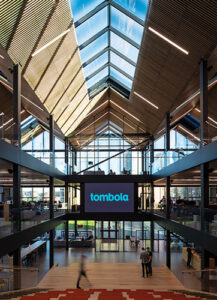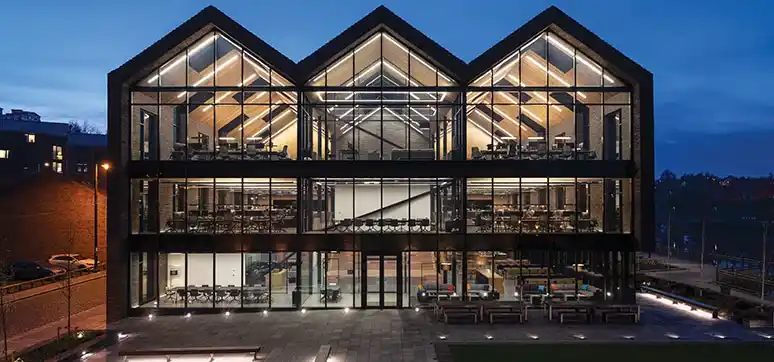Natural light is crucial to the health and well-being of building occupants. However, it can also be a source of glare and visual discomfort.
DIFFERENT SOURCES OF DAYLIGHT GLARE IN BUILDINGS
Daylight glare in our buildings can be caused by different sources:

• Direct view of the sun or the sky when it’s very bright through windows
• Sunlight reflected from windows onto neighboring buildings, the ground (e.g. snow), or water
• Reflections of daylight on screens (e.g. computers, projector screens, notice boards) or other work surfaces. They cause a decrease in the contrast between the visual task and the immediate surroundings, a phenomenon also known as “veiling glare”.
• Reflections of daylight on any shiny or reflective surface in the space directly facing the observer’s eye
• Major contrast between direct or indirect light sources (e.g. illuminated surfaces) and adjacent surfaces
EFFECTS OF GLARE ON OCCUPANTS’ WELL-BEING, HEALTH, AND PERFORMANCE
Although the risks of glare are well known in theory, those are often either overlooked in project planning or handled in an unsuitable way. Project teams may fail to consider the negative effects on the health and well-being of building occupants.
When we are exposed to glare, the effects are of two types. We can experience instant effects: it alters our visual acuity and we are no longer able to see the details of the visual task we are performing. We then need a little time to recuperate our full visual capacity — ranging from a few seconds to a few minutes, depending on the person — and carry on with the activity that was interrupted. We could also still be able to continue with our tasks, but in disruptive or uncomfortable conditions, which requires additional effort on our visual system. Such intense and prolonged strain on our visual system causes visual fatigue.

In work environments, if not well managed, glare can lead to a decrease of 15 % to 21 % in productivity. Besides, one can also expect decreased satisfaction and motivation as an increase in absenteeism, which comes at an extra cost for the company. In schools, poorly managed light influx can create reflections on tables, projector screens, or desks, making it difficult for students to read, write and learn. In terms of medium- to long-term effects, visual fatigue and the migraines caused by glare can directly affect students’ ability to learn and teachers’ performance, as well as their mental state.
In residential care homes and services for elderly people in healthcare facilities, it is also crucial to limit the risk of glare as much as possible for safety and wellbeing, as human visual functions deteriorate with age, for example, people have an increased sensitivity to light and a weaker resistance to glare, etc.
SOLVING THE DAYLIGHTING DESIGN CHALLENGE THANKS TO DYNAMIC GLASS

As we have just seen, poor glare management can have negative repercussions on employees’ performance at work, students’ learning in school, the safety and well-being of the most vulnerable in care facilities — and on people’s health more broadly. The risk of glare must hence be treated with the same seriousness as the risk of overheating, poor air, and sound quality.
That being said, holistic solutions should be found to ensure that access to natural light and views to the outdoors is not compromised. While the role of daylight on circadian well-being and health is well recognized, numerous studies have also demonstrated the psychological and physiological benefits of external views. Views to nature have been shown to particularly support stress reduction as well as cognitive performances.
Furthermore, the Covid-19 pandemic has strengthened the importance of windows and windows’ views, as those are our primary way to connect with the outside world in buildings. A well-thought-out concept combined with smart solar protection solutions like dynamic glazing now allows us to efficiently manage glare while keeping continuous daylight and views.
Dynamic glazing enables to control of the amount of daylight and solar heat entering a space, over a large range varying between 60 % and 1 % in visible light transmission and 0.40 to 0.03 in g-value. The modulation of light and heat can be controlled automatically or manually to dynamically adapt to the external climatic conditions and occupants’ needs.
Not only can dynamic glass help to reduce the energy loads significantly, but it also enables to optimize the indoor daylight levels while preventing the risks of glare without the use of blinds or shades. Since the glass remains transparent in any of the tint states, the view and the connection to the outdoors are always preserved, providing occupants an enhanced experience.
Furthermore, dynamic glass is suitable for a variety of buildings, from offices and schools to healthcare environments, restaurants, and airports. Dynamic glass also allows designers to design with glass to achieve more daylight, maintain exterior views, and meet their aesthetic goals without the energy or comfort penalty.

LATEST DEVELOPMENTS IN DYNAMIC GLASS
In the case of façades using single large panes to span most or all of the floor to ceiling height, dynamic glass with in-pane zoning characteristics is essential in order to effectively co-optimize glare control, daylight quality, and energy performance. Indeed, in many cases tinting the whole façade is unnecessary to block the source of heat and glare. With the ability to have several tint zones within a single pane of glass, glare can be managed through fully tinting one area of the glass, while allowing sufficient qualitative daylight to enter the building by leaving the remaining areas in intermediate and clear states. Recently, dynamic glazing offering a gradual in-pane tint transition from fully clear to fully tinted is available on the market, for an improved targeted solar and glare control. This new and unique dynamic glass solution provides precise glare and daylight control and a smooth visual aesthetic through a natural, seamless pane tint transition.
In summary, dynamic glass offers a unique answer to solve the daylighting design challenge, i.e. achieving high energy performance, daylight harvesting and views, without compromising occupant thermal and visual comfort. Therefore, it changes the way buildings are designed and greatly supports the transition to more sustainable and healthier buildings.














